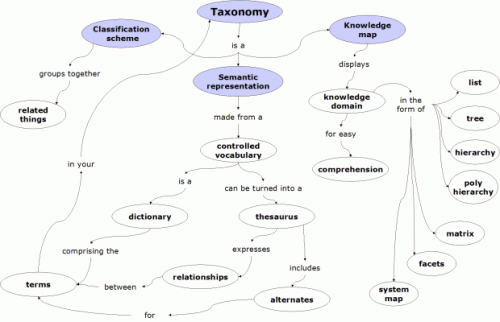"The peculiar character of the problem of a rational economic order is determined precisely by the fact that the knowledge of the circumstances of which we must make use never exists in concentrated or integrated form but solely as the dispersed bits of incomplete and frequently contradictory knowledge which all the separate individuals possess."
F. A. Hayek
Reading the above quotation by Friedrich Hayek it occurs to me that it might be useful to do a posting with suggestions towards a taxonomy of knowledge. Such a taxonomy should be useful in assessing the status of knowledge in a society and thus in identifying particular weaknesses and planning the appropriate means to overcome them.
There are many ways that one can classify knowledge, and they can be used separately or in combination. Note that I am not focusing on classifications of information, such as might be used with modern relational databases, but rather with information that is internalized as skills, knowledge or understanding.
The most common classification of knowledge is by subject, as in the Dewey Decimal System or that of the Library of Congress. Alternative structures, still classifying by subject, are used by encyclopedias, such as the Encyclopedia Britannica.
Knowledge can also be classified by the credibility of its assertions, and there is a great deal of epistemological basis for doing so. In science, for example, more credibility is attached to an observation that has been replicated many times than to one that has been reported by a single laboratory, or to a theory such as the theory of gravity or the theory of evolution that is long established and supported by many observations. The courts accord more authority to a large body of precedent than to a single case. Note that the degree of credibility assigned to an assertion depends on different criteria in different institutions. A scientist may feel that an observation used as forensic evidence has a different level of credibility than does the jury for which it is adduced.
Social/Institutional Embodiment
One can classify knowledge by the way it is embodied. I suggest that the difference between knowledge and information is that someone or something has to “know” it for information to be transformed into knowledge. Knowing involves “remembering/storing” the information and being able to recall or utilize that information. Since the information can not be stored and used without something to do so, one says that the information is embodied when it becomes knowledge. We are most familiar with knowledge of the form of information embodied in people. Increasingly we have information embodied in machinery, such as in robots that are found in many factories or in the control systems for chemical plants. I suggest that more generally, we may consider knowledge to include information embodied in physical plant, thus including that involved in an assembly line, etc. Similarly, information can be embodied in supplies and thus correspond to another type of knowledge. Thus improved seeds embody information developed in the crop improvement research and modern drugs embody information developed through pharmaceutical research and development.
I would also suggest that there is a form of knowledge embodied in institutions. Thus the structure and processes of an organization may not be fully understood by any of its living members, but they represent information that was used to develop an organization that functions effectively. So too, there is information embodied in other institutions. For example, the water temple system in Bali results in the expansion of the rice field system and allocation of water among fields in ways that no one fully understands, but which serves to keep insect populations in check while producing crops of rice.
Thus I suggest the following ways that knowledge is embodied:
- · In people,
- · In plant and machinery
- · In supplies
- · In institutional structure and process
Institutional Processes of Social Construction
I suggest that most knowledge is socially constructed, jointly construed by several or many people rather than held by individual based on direct observation. Social construction takes place within a social context, and one can classify knowledge according to the social contexts in which it is constructed. For example, one could define classes such as the following (from U.S. culture):
- · Scientific knowledge, constructed by a scientific community through a well-known process of theory construction, hypothesis testing, replicated controlled observations, and peer review.
- · Technological knowledge, constructed by technological communities such as engineering, agronomic and biomedical, composed of professionally qualified personnel, or constructed by communities of skilled craftsmen.
- · Judicial knowledge, constructed by trial, based on codified bodies of law and common law, construed by a jury of peers based on presentations by trained and licensed advocates under the supervision of authoritative judges.
- · Legislative knowledge, constructed in legislative bodies through a process of hearings, analysis by full time staff, consultations with constituents and interest groups, and debate in public and in private.
- · Bureaucratic knowledge, constructed within bureaucratic organizations using processes that have been illuminated by decades of studies in management and organizational science.
Culture
The way in which knowledge is socially constructed depends greatly on the culture in which the institutional knowledge system is embedded. Thus judicial knowledge is different in Anglo-Saxon common law systems versus the French Napoleonic legal system or the Arab/Islamic legal system.
We frequently find differentiation between the knowledge of “modern” societies versus traditional knowledge or indigenous knowledge. Local knowledge is used to encompass both the knowledge held by many indigenous communities and many local communities that rely on traditional knowledge sources. So too, in the example above, I have used the term Arab/Islamic as an umbrella term to cover a number of related by differing cultures. Thus the cultural categories lend themselves to hierarchical structures.


No comments:
Post a Comment